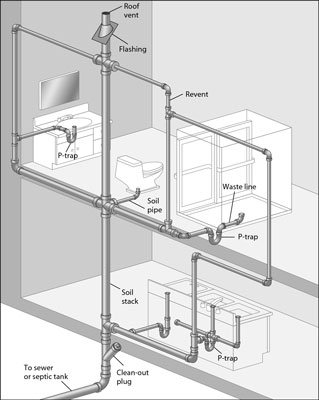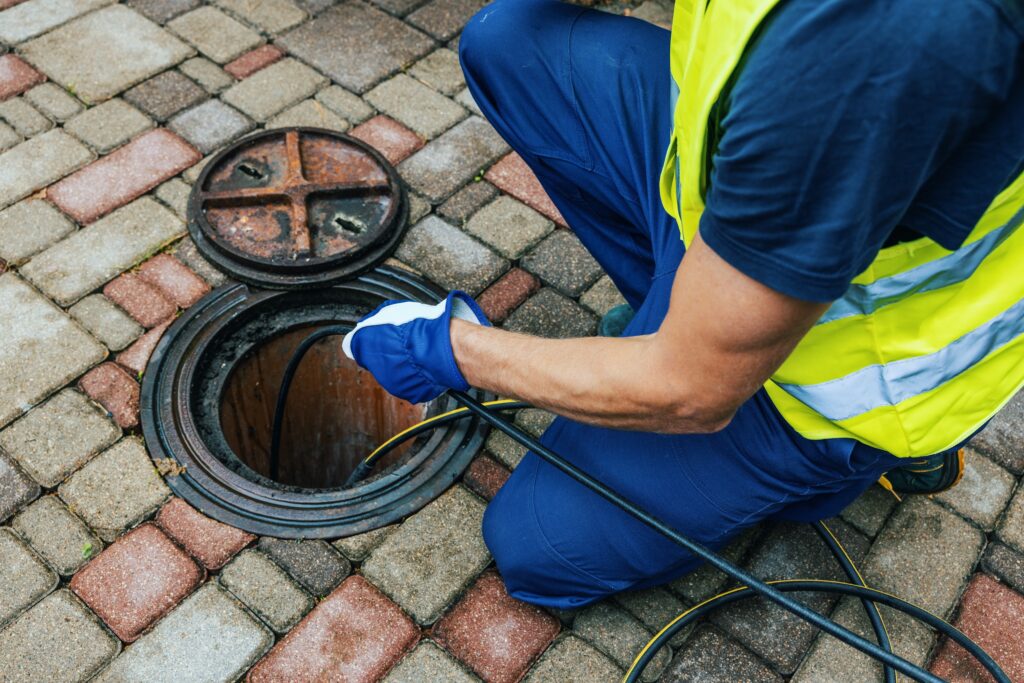Under the house, in the walls, and arriving at many different fixtures, plumbing pipes are everywhere. Pipes run between appliances and out of the house and they come in different shapes, sizes, and materials. Some of them carry gas and others carry water. Knowing the different plumbing pipes in your home will help you to identify problems before they become problems and choose the right type of pipe for your home.

Diagram of your drain-waste-vent system, often called a “plumbing tree” (dummies.com)
Knowing which materials are used for which lines is important for DIY plumbing fixes, but it can also help you identify where your problem is to help speed up a repair when you call for service.
Piping Purpose
Every pipe in a home has a certain function and everything from material to location is determined by what function the pipe serves. Gas lines have different requirements from water lines. You’ll also find differences in incoming pipes (feed lines) compared to outgoing water and gas lines (return lines).
For example: Water return lines take advantage of gravity, with the lowest point of any home draining system leading towards the sewer system. Many of these return systems use large black pipes to clearly identify their purpose and are known as black-water lines. Theses fat pipes residing in the walls of your home carry wastewater to your private tank or into your city’s sewer lines. Large diameter black-plastic pipes leading towards the basement are usually black-water return lines.

Plumbing Pipe Materials
The material used for pipes is often limited to their purpose for code and health reasons. Pipes for water and gas are either some kind of plastic or metal. Hot water feed lines can use chlorinated polyvinyl chloride (CPVC) pipes, crosslinked polyethylene (PEX), or copper piping while PVC can only be used on cold water applications and is not typically used in water supply lines for homes.
Alternatively, PVC and cast iron piping are used extensively for drain-waste-vent (DWV) piping. Most of the return line piping you see will be PVC, cast iron, or even ABS plastic. Cast iron, however, can rust. Call your plumber to replace the rusted sections of your cast iron piping with PVC or ABS piping.
Gas lines are similar, though you won’t find PEX or ABS used for gas. Most gas feed lines use a black malleable metal (some type of iron) between the outside source and the home. Once the lines are moved inside they are typically made of copper or polyethylene.
PVC is sometimes used for underground transportation because it is inexpensive and simple to install in large quantities. Copper is not recommended in all cases since sulfur content can cause flaking in the line which leads to contaminated feed lines and blocked outlets.
Plumbing Pipe Structure
When working with plumbing pipes of any kind it’s important to keep the structural design of your home and your system in mind. Heavier demand with larger volume requires stronger piping.
When you increase the size and strength of your pipes, their weight typically increases, which means support for the system should increase. If you don’t support your system with the proper structure and pipe fittings, leaks will develop and some lines may burst. In the end, it’s always a much better choice to hire a professional to do any repair or retrofit work when installing or replacing gas and water lines within your home.
If you spot any signs of trouble in any of the pipes in your home, contact the professionals at Larry & Sons at (301) 733-5428. Our Frederick, MD plumbing experts are available 24/7 to assist you, and we won’t rest until the issue is properly dealt with.






